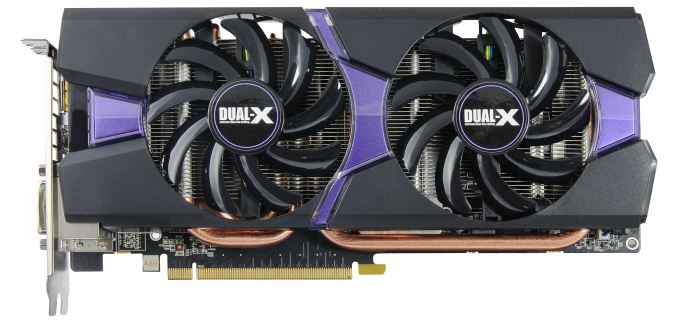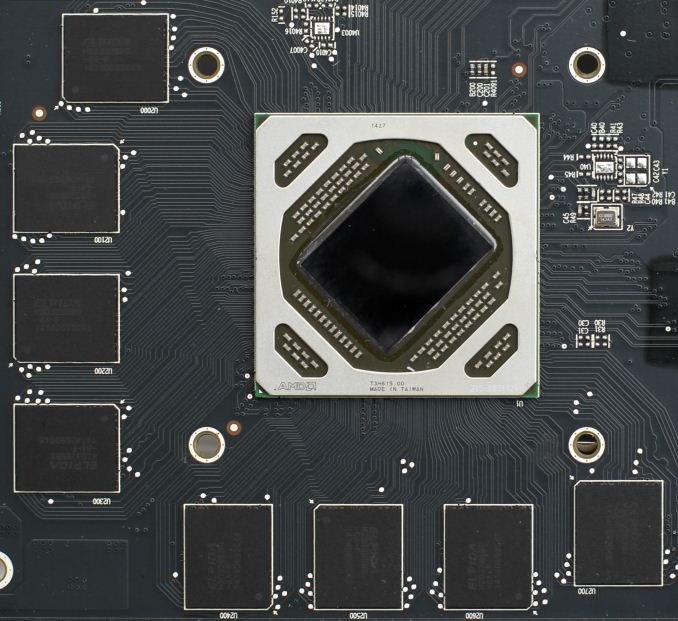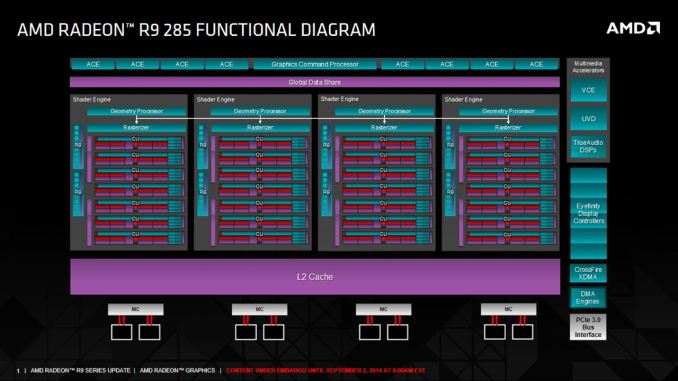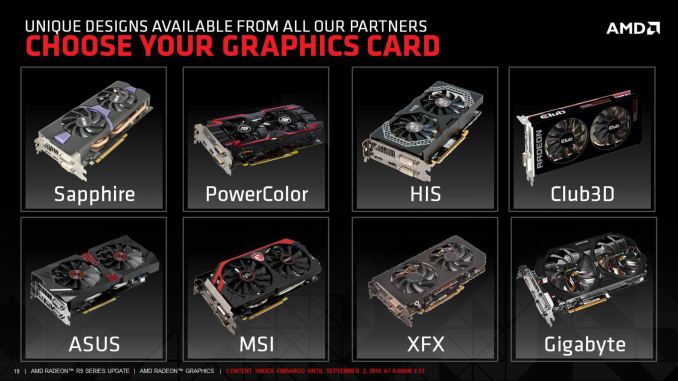AMD Radeon R9 285 Review: Feat. Sapphire R9 285 Dual-X OC
by Ryan Smith on September 10, 2014 2:00 PM EST
Last month AMD held their 30 years of graphics celebration, during which they announced their next Radeon video card, the Radeon R9 285. Designed to be AMD’s new $249 midrange enthusiast card, the R9 285 would be launching on September 2nd. In the process the R9 285 would be a partial refresh of their R9 280 series lineup, supplying it with a new part that would serve to replace their nearly 3 year old Tahiti GPU.
The R9 285 is something of a lateral move for AMD, which is something we very rarely see in this industry. The R9 285’s immediate predecessor, the R9 280 (vanilla) has been on the market with an MSRP of $249 for nearly 4 months now. Meanwhile the R9 285 is not designed to be meaningfully faster than the R9 280 – in fact if you looked at the raw specifications, you’d rightfully guess it would be slower. Instead the R9 285 is intended to serve as a sort of second-generation feature update to R9 280, replacing it with a card at the same price with roughly the same performance level, but with 3 years’ worth of amassed feature updates and optimizations.
To accomplish this AMD has minted a new GPU, Tonga. We’ll go into more detail on Tonga in a bit, but at its core Tonga is in many ways an optimized version of Tahiti. More importantly though, Tonga is also the first GPU in AMD’s next Graphics Core Next architecture revision, which we will come to know as GCN 1.2. As a result, this launch won’t come with a significant shift in AMD’s performance-value, but for buyers it offers an improved feature set for those apprehensive about buying into Tahiti 3 years later, and for enthusiast it offers us a look at what the next iteration of AMD’s GPUs will look like.
| AMD GPU Specification Comparison | ||||||
| AMD Radeon R9 290 | AMD Radeon R9 280X | AMD Radeon R9 285 | AMD Radeon R9 280 | |||
| Stream Processors | 2560 | 2048 | 1792 | 1792 | ||
| Texture Units | 160 | 128 | 112 | 112 | ||
| ROPs | 64 | 32 | 32 | 32 | ||
| Core Clock | 662MHz | 850MHz | ? | 827MHz | ||
| Boost Clock | 947MHz | 1000MHz | 918MHz | 933MHz | ||
| Memory Clock | 5GHz GDDR5 | 6GHz GDDR5 | 5.5GHz GDDR5 | 5GHz GDDR5 | ||
| Memory Bus Width | 512-bit | 384-bit | 256-bit | 384-bit | ||
| VRAM | 4GB | 3GB | 2GB | 3GB | ||
| FP64 | 1/8 | 1/4 | 1/16 | 1/4 | ||
| TrueAudio | Y | N | Y | N | ||
| Typical Board Power | 250W | 250W | 190W | 250W | ||
| Manufacturing Process | TSMC 28nm | TSMC 28nm | TSMC 28nm | TSMC 28nm | ||
| Architecture | GCN 1.1 | GCN 1.0 | GCN 1.2 | GCN 1.0 | ||
| GPU | Hawaii | Tahiti | Tonga | Tahiti | ||
| Launch Date | 11/05/13 | 10/11/13 | 09/02/14 | 03/04/14 | ||
| Launch Price | $399 | $299 | $249 | $279 | ||
Diving into the R9 285’s raw specifications, the card utilizes a 1792 stream processor Graphics Core Next GPU. Paired with these SPs are 112 texture units (in the standard 16:1 ratio), and on the backend of the rendering pipeline is 32 ROPs. As is unfortunately consistent for AMD, they are not disclosing the product’s base clockspeed, but they have published the boost clockspeed of 918MHz.
Meanwhile feeding R9 285’s GPU falls to the card’s 2GB of GDDR5. This is on a 256-bit bus, and is clocked at 5.5GHz for a total memory bandwidth of 176GB/sec.
The R9 285 will have a rated typical board power (AMD’s analogue for TDP) of 190W. Notably this is only 10W higher than the Pitcairn based R9 270X despite the 40% larger SP count, or alternatively is 60W lower than the Tahiti based R9 280. Taking into consideration the R9 270X comparison in particular, it’s clear that AMD has done some work on efficiency to squeeze out more compared to the GCN 1.0 based Pitcairn and Tahiti parts that R9 285 is going to be competing with.
The GPU itself, Tonga, is AMD’s first released GCN 1.2 GPU, with R9 285 arriving before the previously announced Tonga-based FirePro W7100. We’ll dive into further detail into GCN 1.2 on the following pages, but from a high level overview Tonga looks a lot like an optimized Tahiti. AMD has confirmed that R9 285 is not utilizing a “full” Tonga configuration, so R9 285 is not the highest possible configuration for Tonga.
A complete Tonga configuration will contain 2048 SPs, just like its Tahiti predecessor, with 1792 of those SPs active on R9 285. This is paired with the card’s 32 ROPs attached to a 256-bit memory bus, and a 4-wide (4 geometry processor) frontend. Compared to Tahiti the most visible change is the memory bus size, which has gone from 384-bit to 256-bit. In our look at GCN 1.2 we’ll see why AMD is able to get away with this – the short answer is compression – but it’s notable since at an architectural level Tahiti had to use a memory crossbar between the ROPs and memory bus due to their mismatched size (each block of 4 ROPs wants to be paired with a 32bit memory channel). The crossbar on Tahiti exposes the cards to more memory bandwidth, but it also introduces some inefficiencies of its own that make the subject a tradeoff.
Meanwhile Tonga’s geometry frontend has received an upgrade similar to Hawaii’s, expanding the number of geometry units (and number of polygons per clock) from 2 to 4. And there are actually some additional architectural efficiency improvements in here that should further push performance per clock beyond what Hawaii can do in the real world.
The final die size of Tonga is 359mm2 and it packs an unexpectedly high 5 billion transistors. Compared to Tahiti, this is a very slight (7mm2) increase in die size, while the transistor count has gone up by nearly 700M from Tahiti’s 4.31B transistors. Tonga’s configuration and die size indicate that AMD has made some interesting tradeoffs in terms of die size and features. The narrower memory bus means that AMD was able to drop a pair of memory controllers and the memory crossbar, only for AMD to fill it in with the additional transistors needed to drive all of the additional features (and geometry processors) that Tahiti lacked.

Tonga & VRAM. Image Courtesy Hardware.FR
Consequently R9 285 isn’t just a lateral in performance, but from a die size and cost standpoint it should be equally lateral, with Tonga being roughly as expensive to produce as Tahiti. However final boards should be slightly cheaper to produce than R9 280 boards – the 256-bit memory bus allows for simpler boards, it only has 2GB of VRAM instead of 3GB, and the reduced power consumption allows for less complex power delivery circuitry.
Otherwise when it comes to features, being GCN 1.2 based means that the R9 285 will bring with it support for all of the features first introduced in GCN 1.1. This includes support for True Audio, support for bridgeless CrossFire thanks to the XDMA engine, GCN 1.1’s superior boost mechanism, and full support for AMD’s upcoming FreeSync implementation of DisplayPort Adaptive Sync (GCN 1.0 GPUs are not fully adaptive).
AMD will be positioning the R9 285 to compete with NVIDIA’s GeForce GTX 760, the company’s second-tier GK104 part. The R9 280 already compares favorably to the GTX 760, so AMD needs only to not regress to maintain their competitiveness. Meanwhile the GTX 760 was until recently frequently found at $239 – a hair under the R9 285’s launch price – and has since fallen to around $219 in response to the R9 285. What this means is that the GTX 760 has slowly withdrawn itself from competition, taking up a position as a lower performance but cheaper card. It's still NVIDIA's closest competitor at this time, but NVIDIA has wisely realized that they can find a more comfortable spot below the R9 285 rather than trying to compete head-on with it.
The launch of the R9 285 has been a hard launch, and with AMD’s partners producing their own designs this is a pure virtual launch (no reference card) with an MSRP of $249. In our briefing AMD also told us that there will be both 2GB and 4GB cards, and from past experience with split launches like these, we’re expecting most cards to be of the 2GB variety. In fact of the first wave of cards that have hit the market, all of them are 2GB cards with 4GB cards yet to reach shelves. Partially due to this lag between 2GB and 4GB parts, AMD hasn’t been able to give us an estimate on what the 4GB price premium is, but it’s going to be an important fact to take into consideration as the suitability of 2GB enthusiast cards has been challenged by the presence of so much RAM on the current-generation consoles, which will have a knock-on effect on console-to-PC ports.
Meanwhile with the launch of the R9 285 and impending discontinuation of the R9 280, buyers looking at picking up an R9 285 in the near term will have to be on the lookout for R9 280 on clearance sale. It’s already regularly found for $220 and lower, making it $30+ cheaper than the R9 285 and possessing 3GB of VRAM to the R9 285’s 2GB. This will make the R9 280 a strong contender, at least until supplies run out.
Finally, coinciding with the launch of the R9 285 will be a refresh of AMD’s Never Settle bundles. At the gold tier, which will encompass the entire R9 series, AMD is adding Alien: Isolation, and atypically a feature-limited (non-full) copy of Star Citizen to the lineup.
| Fall 2014 GPU Pricing Comparison | |||||
| AMD | Price | NVIDIA | |||
| Radeon R9 290 | $400 | ||||
| $310 | GeForce GTX 770 | ||||
| Radeon R9 280X | $280 | ||||
| Radeon R9 285 | $250 | ||||
| Radeon R9 280 | $220 | GeForce GTX 760 | |||
| Radeon R9 270X | $180 | ||||
| $160 | GeForce GTX 660 | ||||












86 Comments
View All Comments
chizow - Thursday, September 11, 2014 - link
No issues with Boost once you slap a third party cooler and blow away rated TDP, sure :DBut just as I said, AMD's rated specs were bogus, in reality we see that:
1) the 285 is actually slower than the 280 it replaces, even in highly overclocked factory configurations (original point about theoretical performance, debunked)
2) the TDP advantages of the 285 go away, at 190W target TDP AMD trades performance for efficiency, just as I stated. Increasing performance through better cooling results in higher TDP, lower efficiency, to the point it is negligible compared to the 280.
Its obvious AMD wanted the 285 to look good on paper, saying hey look, its only 190W TDP, when in actual shipping configurations (which also make it look better due to factory OCs and 3rd party coolers), it draws power closer to the 250W 280 and barely matches its performance levels.
In the end one has to wonder why AMD bothered. Sure its cheaper for them to make, but this part is a downgrade for anyone who bought a Tahiti-based card in the last 3 years (yes, its nearly 3 years old already!).
bwat47 - Thursday, September 11, 2014 - link
I think the main reason for this card, was to bring things up to par when it comes to features. the 280 (and 280x), were rebadged older high end cards (7950, 7970), and whole these offered great value when it came to raw performance, they are lacking features that the rest of the 200 series will support, such as freesync and trueaudio, and this feature discrepancy was confusing to customers. It makes sense to introduce a new card that brings things up to par when it comes to features. I bet they will release a 285x to replace the 280x as well.chizow - Thursday, September 11, 2014 - link
Marginal features alone aren't enough to justify this card's cost, especially in the case of FreeSync which still isn't out of proof-of-concept phase, and TrueAudio, which is unofficially vaporware status.If AMD released this card last year at Hawaii/Bonaire's launch at this price point OR released it nearly 12 months late now at a *REDUCED* price point, it would make more sense. But releasing it now at a significant premium (+20%, the 280 is selling for $220, the 285 for $260) compared to the nearly 3 year old ASIC it struggles to match makes no sense. There is no progress there, and I think the market will agree there.
If it isn't obvious now that this card can't compete in the market, it will become painfully obvious when Nvidia launches their new high-end Maxwell parts as expected next month. The 980 and 970 will drive down the price on the 780, 290/X and 770, but the real 285 killer will be the 960 which will most likely be priced in this $250-300 range while offering better than 770/280X performance.
Alexvrb - Thursday, September 11, 2014 - link
You just can't admit to being wrong. It maintains boost fine - end of story. That's what I disagreed with you on in the first place. No boost issues - the 290 series had thermal problems. Slapping a different cooler doesn't raise TDP, it just removes obstacles towards reaching that TDP. With an inadequate cooler, you're getting temp-throttled before you ever reach rated TDP. Ask Ryan, he'll set you straight.On top of this, depending on which model 285 you test, some of them eat significantly less power than an equivalent 280. Not all board partners did an equal job. Look at different reviews of different models and you'll see different results. Also, performance is better than I figured it would be, and in most cases it is slightly faster than 280. Which again, I never figured would happen and never claimed.
chizow - Friday, September 12, 2014 - link
Who cares what you disagreed with? The point you took issue was a corollary to the point I was making, which turned out to be true about the theoreticals being misstated and inaccurate when basing any conclusion about the 285 being faster than the 280.As we have seen:
1) The 285 barely reaches parity but in doing so, it requires a significant overclock which forces it to blow past its rated 190W TDP and actually draws closer to the 250W TDP of the 280.
2) It requires a 3rd party cooler similar to the one that was also necessary in keeping the 290/X temps in check in order to achieve its Boost clocks.
As for Ryan setting me straight, lmao, again, his temp tests and subtext already prove me to be correct:
"Note that even under FurMark, our worst case (and generally unrealistic) test, the card only falls by less than 20Mhz to 900MHz sustained."
So it does indeed throttle down to 900MHz even with the cap taken off its 190W rated TDP and a more efficient cooler. *IF* it was limited to a 190W hard TDP target *OR* it was forced to use the stock reference cooler, it is highly likely it would indeed have problems maintaining its Boost, just as I stated. AMD's reference specs trade performance for efficiency, once performance is increased that efficiency is reduced and its TDP increases.
Alexvrb - Friday, September 12, 2014 - link
Look, I get it, you're an Nvidia fanboy. But at least you admitted you were wrong, in your own way, finally. It sustains boost fine. Furmark makes a lot of cards throttle - including Maxwell! Whoops! Should we start saying that Maxwell can't hold boost because it throttles in Furmark? No, because that would be idiotic. I think Maxwell is a great design.However, so is Tonga. Read THG's review of the 285. Not only does it slightly edge out the 280 on average performance, but it uses substantially less power. Like, 40W less. I'm not sure what's Sapphire (the card reviewed here) is doing wrong exactly - the Gigabyte Windforce OC is fairly miserly and has similar clocks.
chizow - Saturday, September 13, 2014 - link
LOL Nvidia fanboy, that's rich coming from the Captain of the AMD Turd-polishing Patrol. :DI didn't admit I was wrong, because my statement to any non-idiot was never dependent on maintaining Boost in the first place, but I am glad to see not only is 285 generally slower than the 280 without significant overclocks, it still has trouble maintaining Boost despite higher TDP than the rated 190W and a better than reference cooler.
You could certainly say Maxwell doesn't hold boost because it throttles in Furmark, but that would prove once and for all you really have no clue what you are talking about since every Nvidia card they introduced since they invented Boost has no problems whatsoever hitting their rated Boost speeds even with the stock reference blower designs. The difference of course, is that Nvidia takes a conservative approach to their Boost ratings that they know all their cards can hit under all conditions, unlike AMD which takes the "good luck/cherry picked" approach (see: R290/290X launch debacle).
And finally about other reviews lol, for every review that says the 285 is better than the 280 in performance and power consumption, there is at least 1 more that echo the sentiments of this one. The 285 barely reaches parity and doesn't consume meaningfully less power in doing so. But keep polishing that turd! This is an ASIC only a true AMD fanboy could love some 3 years after the launch of the chip it is set to replace.
chizow - Saturday, September 13, 2014 - link
Oh and just to prove I can admit when I am wrong, you are right, Maxwell did throttle and fail to meet its Boost speeds for Furmark, but these are clearly artificially imposed driver limitations as Maxwell showed it can easily OC to 1300MHz and beyond:http://www.anandtech.com/show/7764/the-nvidia-gefo...
http://www.anandtech.com/show/7854/nvidia-geforce-...
Regardless, any comparisons of this chip to Maxwell are laughable, Maxwell introduced same performance at nearly 50% reduction in TDP or inversely, nearly double the performance at the same TDP all at a significantly reduced price point on the same process node.
What does Tonga bring us? 95-105% of R9 280's performance at 90% TDP and 120% of the price almost 3 years later? Who would be happy with this level of progress?
Nvidia is set to introduce their performance midrange GM104-based cards next week, do you think ANYONE is going to draw parellels between those cards and Tonga? We already know what Maxwell is capable of and it set the bar extremely high, so if GTX 970 and 980 come anywhere close to those increases in performance and efficiency, this part is going to look even worst than it does now.
Alexvrb - Saturday, September 13, 2014 - link
You were wrong about it being unable to hold boost, you claimed that GCN 1.1 can't hold boost despite clear evidence to the contrary. Silly. Then you were wrong about Maxwell and Furmark - though you kind of admitted you were wrong.Regarding that being a "driver limitation" you can clock a GPU to the moon, and it's fine until it gets a heavy load. However most users won't even know they're being throttled. I had this same discussion YEARS ago with a Pentium 4 guy. You can overclock all you want - when you load it up heavy, it's a whole new game. In that case the user never noticed until I showed him his real clocks while running a game.
Tonga averages a few % higher performance, dumps less heat into your case, and uses less power. Aside from this Sapphire Dual X, most 285 cards seem to use quite a bit less power, run cool and quiet. With all that being said, I think the 280 and 290 series carry a much better value in AMD's lineup. I'm certainly not a fanboy, you're much closer to claiming that title. I've actually used mostly Nvidia cards over the years. I've also used graphics from 3dfx, PowerVR, and various integrated solutions. My favorite cards over the years were a trusty Kyro II and a GeForce 3 vanilla, which was passively cooled until I got ahold of it. Ah those were the days.
chizow - Monday, September 15, 2014 - link
No, I said being a GCN 1.1 part meant it was *more likely* to not meet its Boost targets, thus overstating its theoretical performance relative to the 280. And based on the GCN 1.1 parts we had already seen, this is true, it was MORE LIKELY to not hit its Boost targets due to AMD's ambiguous and non-guaranteed Boost speeds. None of this disproved my original point that the 285's theoreticals were best-case and the 280's were worst-case and as these reviews have shown, the 280 would be faster than the 285 in stock configurations. It took an overclocked part with 3rd party cooling and higher TDP (closer to the 280) for it to reach relative parity with the 280.Tonga BARELY uses any less power and in some cases, uses more, is on par with the part it replaces, and costs MORE than the predecessor part it replaces. What do you think would happen if Nvidia tried to do the same later this week with their new Maxwell parts? It would be a complete and utter disaster.
Stop trying to put lipstick on a pig, if you are indeed as unbiased as you say you are you can admit there is almost no progress at all with this part and it simply isn't worth defending. Yes I favor Nvidia parts but I have used a variety in the past as well including a few highly touted ATI/AMD parts like the 9700pro and 5850. I actually favored 3dfx for a long time until they became uncompetitive and eventually bankrupt, but now I prefer Nvidia because much of their enthusiast/gamer spirit lives on and it shows in their products.